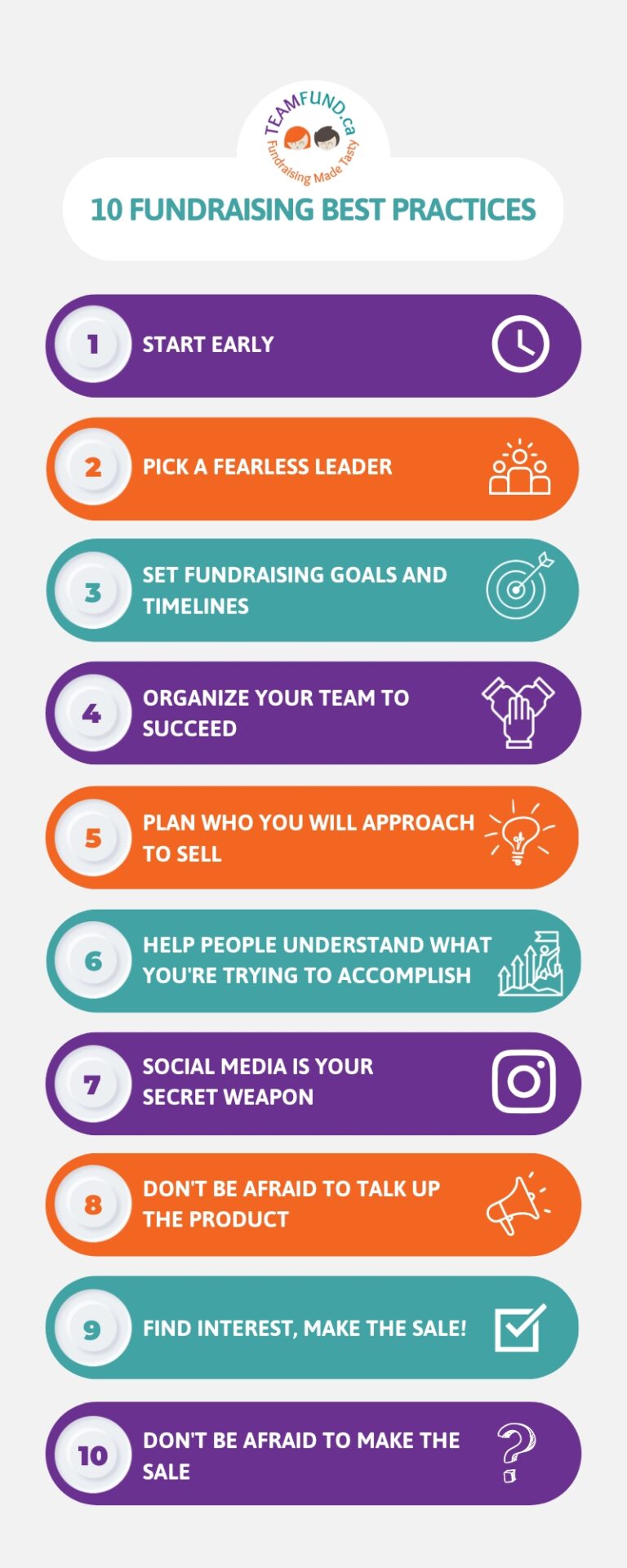How to Fundraise
Youth sports clubs and non-profits are made possible by fundraising, but how do we ensure we are doing our best to raise money for our cause?
Maybe you’re a new board member for a minor sports team or the fundraising director for a non-profit and have been put in charge this year.
We hope this ultimate fundraising guide gives you the answers you’re looking for – we have filled it with our best fundraising tips!
How Does Fundraising Work?
Across Canada, teams, schools, and minor sports clubs are looking for ways to raise money so they can attend tournaments/competitions, afford new equipment, or assist with overhead costs.
Fundraising isn’t the most attractive role (did you know the most vacant position in clubs is fundraising?). However, fundraising is critical to ensure youth sports remain affordable and youth have the opportunity to compete at a higher level without immense financial burden.
Every year, selfless parents volunteer their time to help fundraise for their child’s minor sports teams. These committed parents help by going out and selling all types of products: foods, raffle tickets, calendars, poinsettias, coupon books, and more.
Through effective fundraising, their kids can get the most out of their school or minor sports team.
School fundraising and fundraising for non-profits and sports teams can be a challenge.
After making a clear goal for what they want to accomplish, the school or team needs to decide what fundraiser they’re doing that year.
With hundreds of products and fundraising systems available across Canada, there is a lot of variety. Once you’ve decided on your product of choice to sell, typically, the team buys as much inventory of the product they need to sell to reach their fundraising goals.
After that, it’s up to the parents and kids to get out and get selling.
Need help landing the sale? Check out the Sales 101 section!
Orders and money may need to be tracked manually so that each dollar is accounted for, and the products usually end up split up into a couple of parent’s garages to accommodate the volume. Parents and kids can now take these products out into the world and hopefully sell enough to reach their fundraising goals.
Want to stop tracking manually and carrying inventory?
Try online fundraising with TeamFund – you promote to supporters, while we take care of the rest!
Why Fundraising is a Better Option Than GoFundMe or Cash Calls
Technology has moved forward over the years, and so has fundraising. The advances of the internet and social media have provided great options to fundraise for teams and schools!
One of the newest ways teams are approaching fundraising is through GoFundMe.
GoFundMe is a centralized online platform that allows people to accept donations for their cause. People have used GoFundMe for all manners of fundraising: from startups raising money for developing their products to helping people in need to raise funds for hospital bills. As a fundraising platform, GoFundMe brings a lot to the table for accepting donations.
While GoFundMe is set up exceptionally well to take donations, when it comes to delivering the goods to people you’re selling to, you’ll need to take care of that yourself.
Cash Calls are another great option to raise funds for your team. It’s fast and straightforward, just request the cash upfront for all your team’s needs directly from the parents.
The drawback to cash calls is that parents who may not be as economically secure immediately feel the pressure when cash calls are announced. It may not seem like much money, but when you’re counting on a few extra dollars around the house, it can be a cause for stress for parents.
Fundraising by selling products brings a lot to the table that GoFundMe and Cash Calls cannot offer.
Putting yourself out there to sell products to your friends and family can be daunting (and even feel a little awkward) if you’re not used to it.
However, it allows you to connect with your community, gain a sense of accomplishment, and raise the money you need!
The top reason people like fundraisers over donations and cash calls is because buyers get something back.
With cash calls and donations, minor sports teams are just asking for money. While it can be effective, it can also drive a wedge between parents who may not have the cash to spare or aren’t interested in donating.
Fundraising puts something of value into the buyer’s hands that they can enjoy or use while still being able to contribute to their child’s team.
Fundraising also gives parents the option to use their time to raise money for their team. When cash is tight, having the opportunity to volunteer can alleviate a lot of stress, and allow parents to still provide a significant contribution to the team.
Online Food Fundraising is the Next Best Fundraising Idea – Here’s Why…
At TeamFund Fundraising, we are massive advocates of using food as your fundraising product. And there is a couple of reasons for that:
Food Is Something Most People Will Actually Use & Enjoy
When was the last time you received or purchased a coupon book or a gift card? Did you use it?
While there are many items you could sell for your fundraiser, not all of them are things people are actually going to use.
In 2015, over $970 million in gift cards went unused, with a percentage of them being sold through fundraisers. It’s similar to items like wrapping paper or carnations: people feel compelled to buy the products to help support the team even if they don’t need the item.
Online fundraising with food is effective because it gives buyers something they are going to use and makes selling the product much easier. Everyone needs to eat!
People no longer feel guilted into buying for a fundraiser each year, and instead, look forward to restocking their freezer with products they’ll use or buying bacon for less than the cost at the grocery store!
20%-25% Profit Per Sale
Outside of straight donations, food fundraising is one of the highest profit items you can fundraise with.
Different foods in our Alberta and Winnipeg fundraisers tend to have somewhere in the range of 5%-25% markup in any supermarket. By dealing directly with the wholesaler, those profits are transferred directly to your team.
In fundraising, every dollar counts. Using a bigger ticket item that can bring in more money per sale can go a long way to making your fundraiser faster and easier.
Learn About TeamFund’s Online Food Fundraisers:
How to Motivate Your Team
Fundraising is a team effort that requires everyone to band together and do their best to reach your fundraising goals.
But how do you even get your team motivated?
Get Together To Get Motivated
Your first meeting with your fundraising team should help your group get excited about your fundraiser.
It’s an opportunity to introduce the plan and explain how it’s going to work. Be sure to note the purpose of your fundraiser and help everyone recognize the benefits of the fundraiser you’ve chosen.
Also, try to make it fun! Here are some ideas:
- Try to come up with strategies to spread the word to friends and family members
- Think of a cheer or slogan for the fundraiser
- Share motivating quotes
- A motivational meeting could also be held mid-way through the fundraiser to review results so far and boost enthusiasm before the fundraiser ends.
Celebrate Progress
The right incentives can be very motivating to team members. A big part of building enthusiasm will involve giving regular updates on how the fundraiser is going and providing positive feedback on minor and major wins.
There are many creative ways to show and celebrate progress:
- Post up a goal thermometer, use a hockey stick or swimming lane as a visual (Get creative here! What is a shape you can use that relates to your organization?)
- Chart the progress and cheer each other onto the next level.
- Think about having a fun activity planned for each target reached. Maybe, once they reach 50% of their goal, the team gets to pick their own drills at the next practice. What about letting the team make the coaches do the exercises once they reach 75%?
Whatever you decide, make sure that it doesn’t pit one member against another, but instead rewards everyone. After all, you are a team that is in it to win it together.
Keep the Fundraiser Fresh In Their Minds & Encourage Participation
Always remember to keep the fundraiser in mind for all the volunteers, parents, and supporters. It can be easy for people not directly involved in raising money to forget that the team is fundraising.
Be sure you have access to the team social media or email list to ensure you can keep everyone in the loop.
Be sure to take opportunities to remind and encourage everyone regularly.
- Let everyone know when you reach each milestone or target.
- Share updates such as how much more you need to reach your goal.
It’s possible that just knowing how close they are to success will motivate them to find those last few supporters. Building enthusiasm will get more people interested and excited to be involved.
Stay Positive & Avoid Comparison
Maintaining a positive attitude is essential to building enthusiasm during a fundraiser.
You’re going to run into roadblocks along the way, and sometimes it may feel like you’re not going to reach your goal. However, keeping focused on how far you and your team have come is essential.
Make sure that parents and volunteers concentrate on being supportive and avoid unhealthy competition or comparisons.
Keep upbeat about your progress, and others will mirror your enthusiasm.
Give Others Skills & Let Them Lead
To maintain and build enthusiasm, you might need to teach your team some new skills so that they can lead the charge.
Many people might be unsure or uncomfortable about the idea of selling or pitching the team’s fundraiser, so offering a little helpful insight can go a long way.
Teaching your team:
- Communication skills
- How to recognize interest
- Benefits/features of the product you’re selling
- Confidence in the team and your goals
encourages potential buyers.
Clear, concise, and confident language can go a long way to helping people understand what you are trying to accomplish and why they should buy from you.
These new skills will help your team to push your fundraiser forward.
Seeing how their unique talents and personal involvement can help the team reach their goals can be rewarding and motivating.
Fundraising Sales 101: Getting Supporters to Buy!

Reaching your fundraising goals comes down to making sales. But how to do you crush out those numbers and land the sales that you need to raise money for your team?
Plan Out Your Sales Approach
The first step to any sales plan is planning out who you are going to approach to sell.
Think through people you know who are likely to want to support your team or who would be interested in the products you are selling.
Chances are, a few names will spring to mind. Trust your instincts and follow up with those names.
Help People Understand Why You’re Selling
One of the keys to getting people on board with buying your product is understanding why you are doing it.
Think through the story of achievement you are setting out to accomplish by raising money, and how it will benefit your child’s minor sports team.
Learn more about telling your story for more sales
People will be much more willing to support a minor league hockey team raising money to go to the big local tournament rather than an old friend calling them up out of the blue and asking if they want to purchase a product you’re selling.
Social Media Is An Excellent Way To Get The Message Out
It’s 2023, and sometimes that means it’s hard to reach people you know by phone. However, the rise of social media has become an effective secret weapon for people-savvy fundraisers.
Reach out to the people you’ve identified on social media and send them an honest message. Most of the time, people will be receptive to you if they understand your cause.
Currently, Facebook is by far the easiest social media platform to identify and find people that you are looking for.
Don’t be shy, get out there, and connect to make that sale!
For more on social media, check out our article how to use social media to promote your fundraiser
Don’t Be Afraid To Ask For The Sale
One of the hardest parts of sales is closing. You can get someone interested and excited about your product one day, and the next, they’re on to the next thing. Don’t be afraid to ask for the sale when people are showing interest.
It doesn’t need to be aggressive, but you do need to make your intentions clear. If a potential sale is showing interest and asking a lot of questions, simply ask them, “would you like to buy this right now?”
Be clear and confident, don’t push someone into buying, but allow them to decide on whether they’d like to buy. You’ll find your sales rate increases dramatically when you simply ask for the sale.
10 Fundraising Best Practices That Will Ensure Your Fundraiser is a Success

1. Start Early
Fundraising takes more time than you think. On average, TeamFund’s fundraisers take less than a week to get organized, however, TeamFund has everything you need already prepared.
For other fundraisers, you may want to start getting organized at least a month in advance, depending on how much you’re looking to raise.
Research & pick your fundraiser as early as possible. Fundraising is an exciting proposition because it means getting the cash to help your team do what they want to do. However, not every fundraiser is right for every minor sports team or school event. Start your research early and find the right fundraiser for your group.
2. Pick A Fearless Leader
Fundraising can be a daunting task that requires a clear head and unwavering motivation. Picking a leader who knows the fundraising drill and has the gumption to reach the goal is invaluable to your fundraising efforts.
Have your leader plant the flag and set your goals. When you are fundraising, you’ll have milestones, achievements, and an ultimate goal. Have your leader establish that goal clearly, and help your team see progress towards it. It will help motivate the team to reach your fundraising goals.
3. Set Fundraising Goals & Timelines
Before anything else, know how much money you need to raise in your fundraiser. Trips, tournaments, and equipment all should have set prices that set a goal for you to reach. Do not start fundraising just to raise as much as you can, or you’ll quickly find your fundraising team and buyers losing interest.
Know your deadline, and don’t go past it. Every fundraiser should have an established deadline to reach your goal. Having a deadline motivates people to prioritize fundraising and helps keeps your fundraising timeline in check.
Read more about setting S.M.A.R.T. Goals for your fundraiser
4. Organize Your Team To Succeed
Find reliable help for your fundraiser. Fundraising is a group effort that takes a team of people time and energy to achieve their goals. Finding reliable people to help you reach your fundraising goals will make the process much easier, and help you raise more money.
Help volunteers see the value of the fundraiser. No one wants to be “volunteered” into doing work they don’t understand. Help your fundraising team understand what the team is trying to achieve and keep that sentiment top of mind when the team is going out selling.
Always remember to delegate. It is easy to get carried away thinking that because you are in charge, the responsibility of the fundraiser falls on your shoulders. But, if you have a committed team, you can get much more done in a shorter timeframe with less stress to the whole group. Remember, ten volunteers working for one hour will leave them less stressed than one person working for 10 hours. Delegate responsibilities to get the job done quickly and well.
5. Plan Out Who You Are Going To Approach To Sell
The first step is to know your audience. Who is would be willing to support your cause? Who is interested in what you are selling? Who can you easily reach to show your products? Take some time to answer these fundamental questions, and you’ll quickly develop a list of people you want to reach out to.
Know your sales points for your product. People want to know why they should give you money for what you’re selling. Make sure you understand why your product is amazing.
For the meats at TeamFund, we know they are from local vendors, the food is restaurant quality or higher, and that some of the foods are organic, to name a few points.
TIP: Write down three reasons why what you’re selling is something you would buy. Outlining these benefits will help customers understand why they want to buy from you.
Communicate with people, don’t sell at them. People don’t want to be sold to, but people do want to be spoken with. Move away from telling people they need to buy, buy, buy, and instead help them understand why you are selling and what’s in it for them if they do end up buying.
6. Help People Understand What You’re Trying to Accomplish
Every fundraiser is a gateway to doing something new and awesome for your team or school. Help people understand what you are trying to accomplish. People like to be support teams and schools that are trying to help kids do something new. They’re far less receptive to being sold meat over the phone.
People recognize striving for goals and usually want to help. Let people know exactly whats going on in your fundraiser and how close you are to your goal and deadline. You can motivate people to help you simply by showing where you are.
7. Social Media Is Your Secret Weapon
Friends, family, and acquaintances are all on social media these days. It’s easy to connect with them with a simple message on Facebook or DM through Instagram. It’s especially convenient for reaching out to people who you may not have their phone number.
You can gauge who may be interested in what you’re trying to do. Social media is a great place to get an idea of what someone’s interests are. If you’re not sure if someone would be interested in supporting your team, check their Facebook account. It may give some indications that they’d be interested in supporting your cause.
8. Don’t Be Afraid To Talk Up The Product
Have faith in the product that you’re selling. You’re selling someone a product, and they need to have confidence that what you are selling is something they want. Whatever the product is, own it. Have your sales points ready, be prepared to answer any questions a buyer might have, and help them understand why it’s something that they want.
9. Find Interest, Make The Sale
Being able to identify someone’s interest in supporting your fundraising is a critical skill. Not everyone who listens to you will be a buyer, and not everyone who ignores you will be a dead lead. A good indicator of someone’s interest is to see if they’re asking questions about your cause and your product. Questions run out fast if someone isn’t interested in learning more. Keep that in mind and help determine who will be a supporter.
Don’t be afraid to cut cold leads. Sometimes, people just slip away or lose interest, and that is ok. Don’t waste your energy on people who are not interested and focus your energy on the next potential sale.
10. Don’t Be Afraid To Ask For The Sale
Don’t leave any room for interpretation. When you have found someone that is showing interest, is asking questions, and wants to support your team, ask them straight out if they are interested in buying your product. You don’t need to be aggressive, but you shouldn’t leave room for interpretation. Show a buyer that you want them to buy. People want to feel wanted and respond positively to outreach and support. Tell the potential sales that you would value their support.
Fundraise for any season and any reason with TeamFund Fundraising!
Follow us on social media to stay up-to-date!








